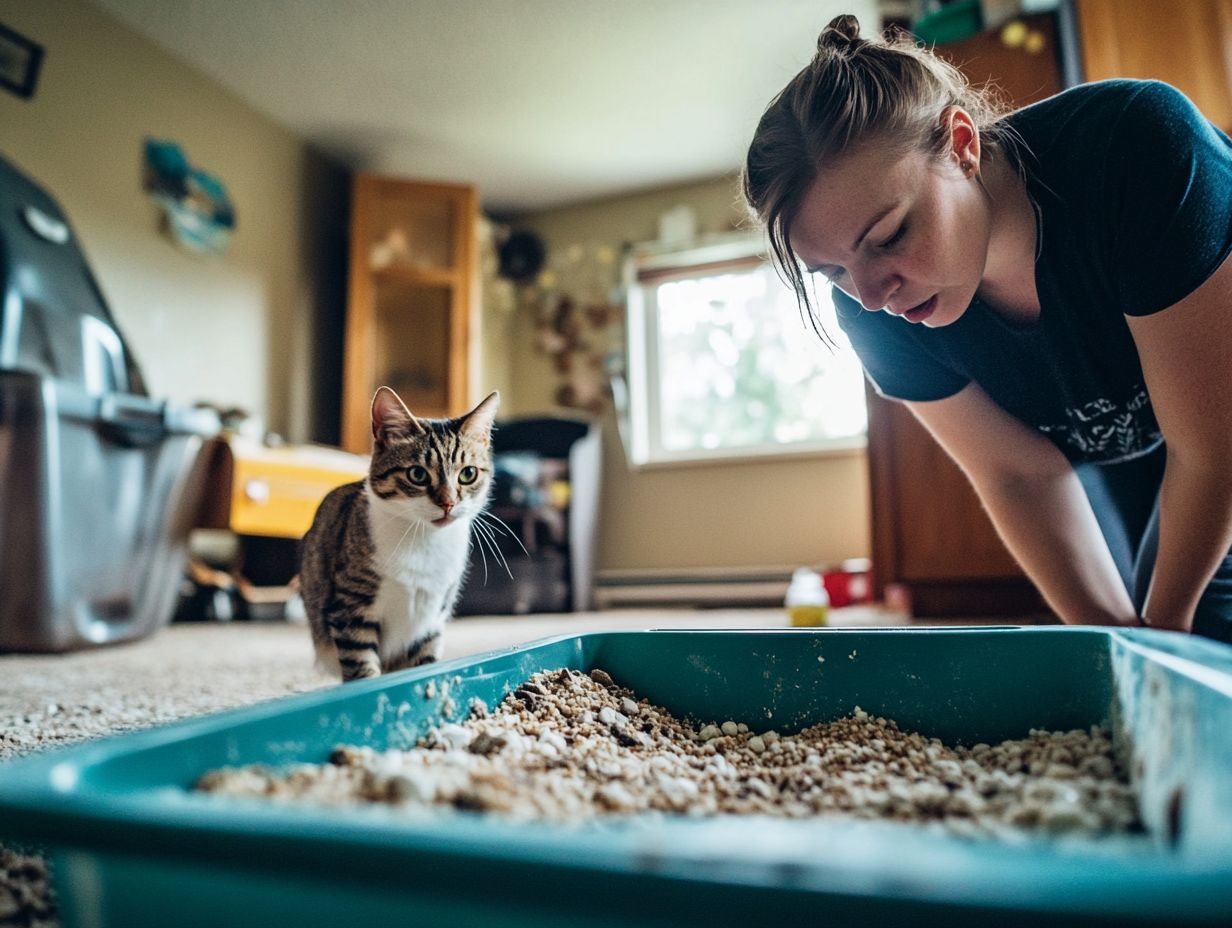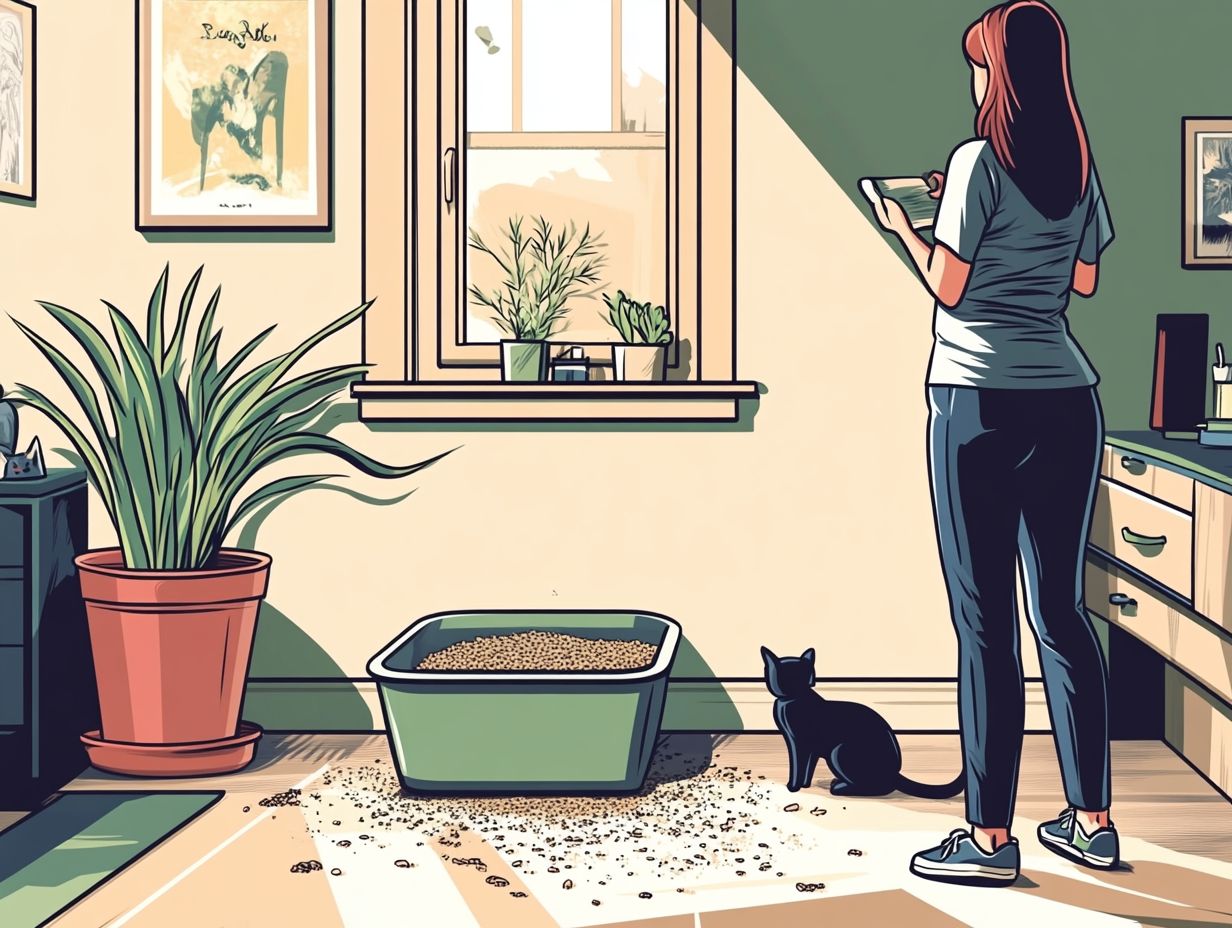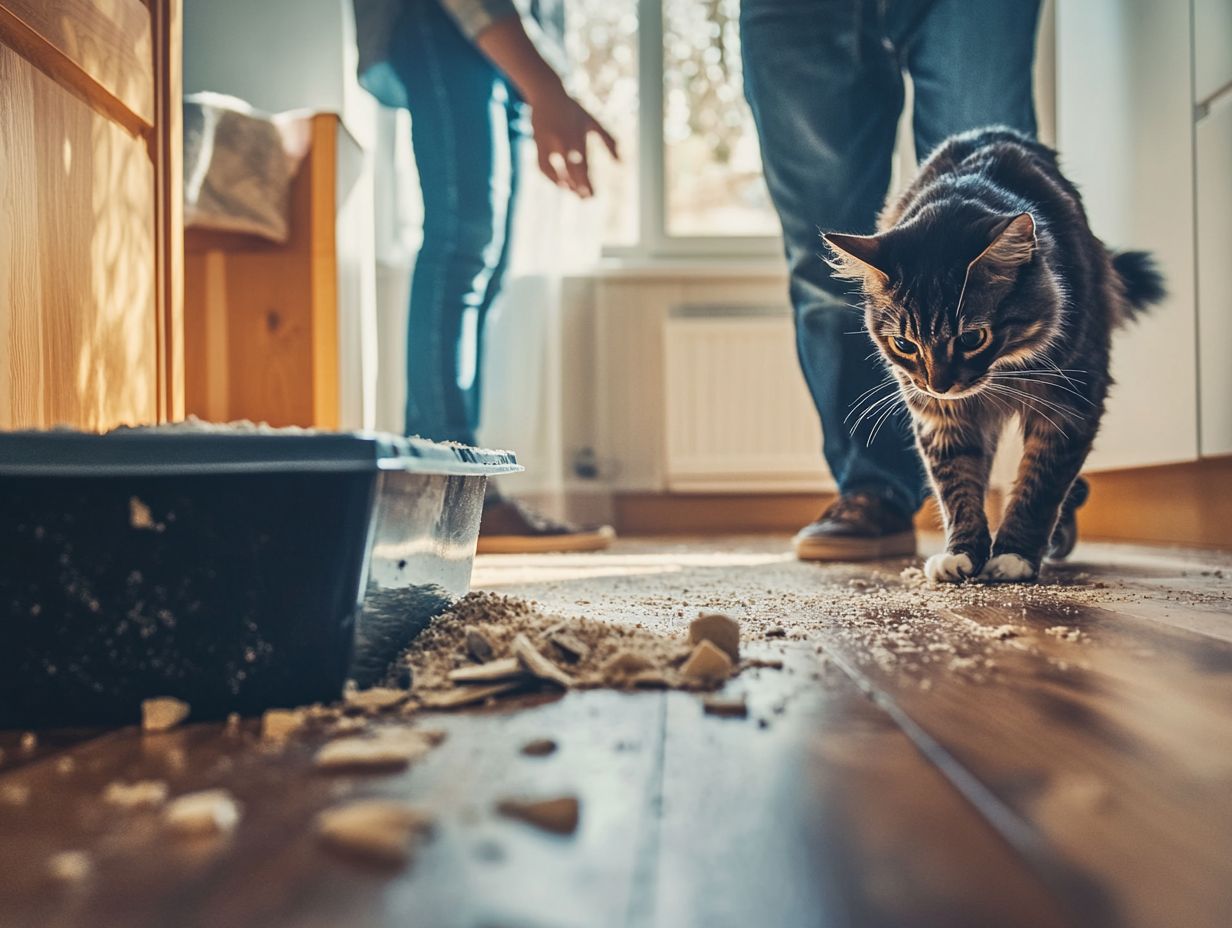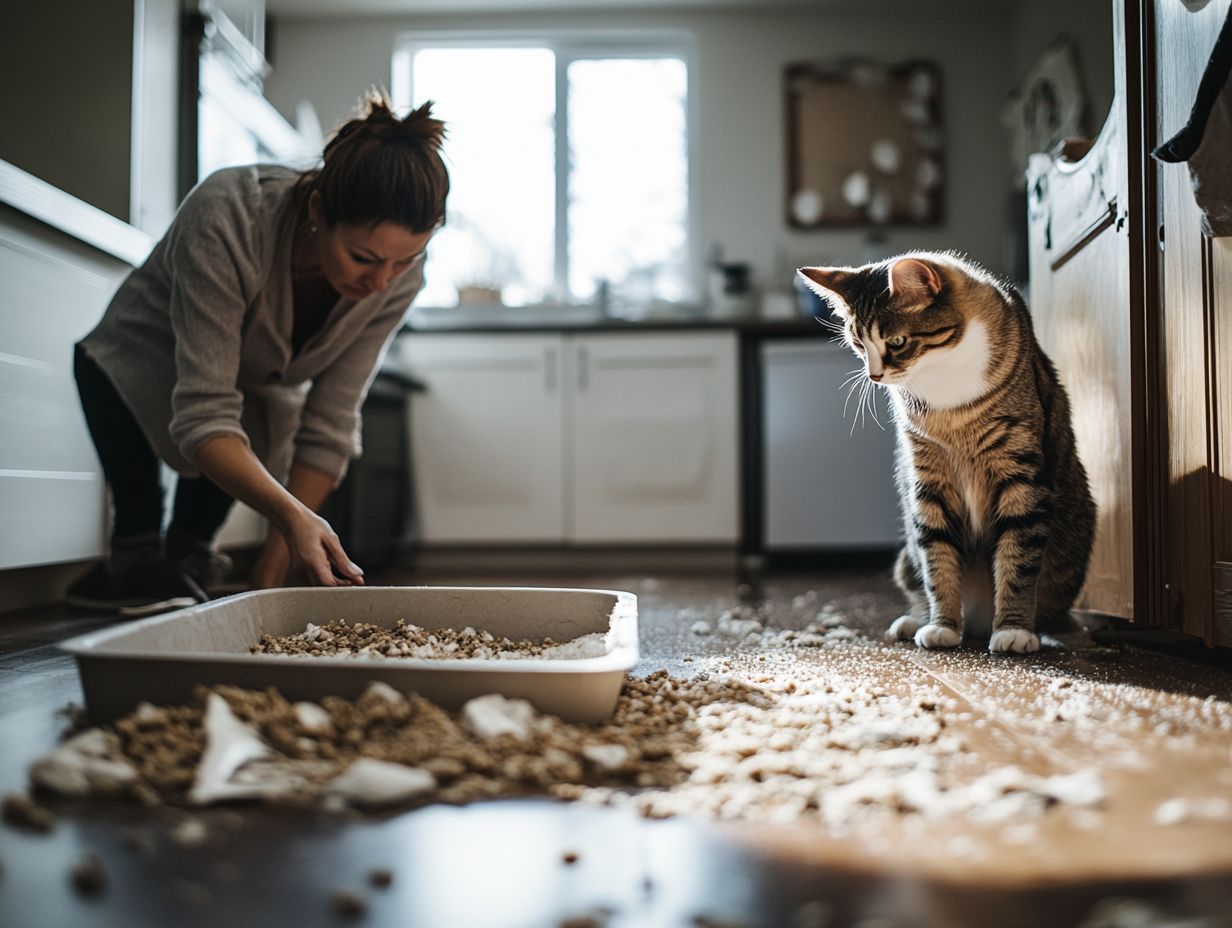Cats are generally fastidious creatures, but when they start pooping outside the litter box, it can be a frustrating issue for many cat owners, often requiring a vet visit to rule out any health problems.
Understanding the underlying causes is crucial to resolving this behavior. Stress can be caused by environmental changes, such as new pets or moving homes, along with medical issues like gastrointestinal problems and arthritis. Several factors can influence your cat’s bathroom habits, including the litter box location and type. Observe your cat’s behavior and environment to identify stressors.
This article explores common reasons for litter box problems, including behavioral issues and environmental concerns, offers solutions such as stress reduction and training, and provides tips to encourage your feline friend to use the litter box consistently.
If you’re struggling with this issue, keep reading to uncover effective strategies, including maintaining clean litter and a consistent cat’s routine, for a happier, healthier cat.
Key Takeaways:

- Cats may poop outside the litter box due to medical issues like diabetes or cognitive dysfunction, stress, or litter box preferences such as litter type and cleanliness.
- To address litter box problems, rule out medical issues such as urinary tract infections, reduce stress with products like Feliway, and adjust litter box location or preferences, including using clumping litter or unscented litter.
- Encourage cats to use the litter box by keeping it clean—ideally, scoop daily and change the litter weekly—providing multiple boxes in different locations, and using the right type of litter, such as soft clumping litter.
Understanding Litter Box Problems in Cats
Understanding litter box issues in cats is essential for maintaining feline health and ensuring a harmonious household. Cats may refuse to use their litter box for various reasons, including health problems, behavioral issues, and changes in their environment.
Recognizing these factors is crucial for effectively addressing the problems. From gastrointestinal issues to stress-related behaviors, cats are sensitive creatures that need a clean and comfortable space—ideally cleaned daily with unscented, soft clumping litter—to relieve themselves. Elements such as the number of litter boxes (recommend one box per cat plus one extra), the type of litter used, and the box’s location can significantly influence their behavior.
By understanding these aspects, owners can create an optimal environment for their cats, considering factors like household dynamics and the presence of a new pet.
What Are the Common Causes of Cats Pooping Outside the Litter Box?
Cats may poop outside their litter box for various reasons, and understanding these common causes is essential for effective intervention. For more information, check out Why Do Cats Poop Outside the Litter Box? Top Causes and Fixes.
- Medical Issues: Gastrointestinal problems, urinary tract infections, or arthritis in older cats can prevent them from reaching the litter box in time.
- Behavioral Issues: Stress, anxiety, and changes in their environment can also lead to litter box accidents.
It is crucial for pet owners to assess the location, type, and litter used in their cat’s litter box to ensure that their cat feels comfortable and secure while using it. Additionally, having a clear understanding of the cat’s routine and preferences can provide valuable insights into potential solutions.
1. Medical Issues
Medical issues are one of the primary reasons cats may refuse to use their litter box, often signaling underlying health problems that need prompt attention. When animals are unwell, conditions such as gastrointestinal issues, urinary tract infections, and arthritis can significantly disrupt their normal behavior.
For instance, a cat suffering from a urinary tract infection may associate the litter box with pain and start to avoid it. Similarly, an older cat with arthritis might find it physically painful or challenging to enter or jump into litter boxes that are not conveniently located near their resting area.
Therefore, if a cat shows signs of avoiding its litter box—usually an indication of discomfort—it is crucial to consult a veterinarian. They can perform tests and offer answers to alleviate any discomfort.
2. Stress or Anxiety
To address litter box problems, it’s important to reduce stress and provide a safe space for your cat. Consider consulting with a veterinarian for personalized advice based on your cat’s specific situation.
In conclusion, understanding your cat’s litter box habits is essential for their health and your peace of mind. If you suspect any medical issues, consult a vet immediately. Additionally, creating a comfortable environment and observing for potential stressors can help ensure your cat uses the litter box consistently.
Stress or anxiety in a cat can significantly alter its behavior, often leading to litter box issues as the animal feels insecure in its environment. Changes in the household, the addition of new pets, or even alterations in the owner’s daily routine can elevate anxiety levels in cats, resulting in behaviors such as territorial marking or a complete refusal to use the litter box. To verify claims regarding stress and anxiety in cats, it’s essential to consult reputable sources such as veterinarians or animal behaviorists.
Identifying these key stressors and implementing solutions like Feliway—a synthetic pheromone product designed to mimic calming feline pheromones—can help alleviate anxiety and restore normal behavior.
Environmental factors also play a crucial role in feline stress; sounds, rearranged furniture, and new scents can all contribute to a cat’s feelings of insecurity. Owners may not even realize that something seemingly harmless, like nearby construction or a visiting family member, could disrupt the cat’s routine.
To combat the effects of anxiety, it is essential for owners to create a calm environment that includes safe hiding spots and stimulating toys. Here’s a quick checklist for creating a calm environment:
- Provide safe hiding spots.
- Use stimulating toys for engagement.
- Maintain consistent feeding and playtime.
Additionally, maintaining consistent feeding and playtime can provide structure and stability in the cat’s life.
3. Litter Box Preferences
Understanding a cat’s litter box preferences is essential for preventing accidents and promoting consistent use. Cats have specific preferences regarding the type of litter, such as whether it is soft, unscented, or clumping—each with unique benefits. For example, clumping litter absorbs moisture and makes cleaning easier, while non-clumping litter may be less messy.
Soft litter, often made from materials like recycled paper or natural grains, may be preferred by some cats for its gentle texture on their paws. One of the most crucial factors for a cat’s behavioral well-being is the cleanliness of the litter box. A dirty litter box can contribute to the development of behavioral issues in cats.
4. Location of the Litter Box

The location of the litter box is one of the most crucial factors influencing its usage by cats. A litter box placed in the right spot can significantly affect whether a cat will use it. Cats prefer their litter boxes to be in quiet, out-of-the-way areas where they feel safe and secure.
If a litter box is situated in a high-traffic area or near loud noises, the cat may refuse to use it and have accidents elsewhere in the house. Ideally, cat owners should have one litter box per cat plus one extra; for a household with two cats, that means three boxes total.
Providing multiple litter boxes in different locations can help meet your cat’s territorial needs and increase the likelihood of proper usage. According to American veterinarian and researcher John Paul Scott, who is renowned for his studies on feline behavior, cats exhibit both instinctual and learned behavior patterns that influence their choice of elimination spots.
To enhance the chances of litter box use, it is essential to consider their natural instincts. Cats tend to gravitate toward areas where they feel secure and private. By placing boxes away from busy household areas, such as living rooms or bustling kitchens, you create a space that respects their need for privacy.
Moreover, having more than one box allows cats to claim their territory and can help reduce stress, which is particularly important in households with multiple cats that may compete for resources. Proper placement of the litter box can make the experience more pleasant and rewarding for your feline friend.
How to Address Litter Box Problems in Cats?
Addressing litter box problems in cats is a step-by-step approach that takes into account health, behavioral, and environmental factors. The first step is to eliminate any medical concerns by having a veterinarian examine the cat. This ensures that the cat is not facing any underlying health issues that could contribute to behavioral problems. If the cat is healthy, pet owners can then focus on reducing stress factors, accommodating the cat’s preferred litter box characteristics, and adjusting the litter box location to encourage its use. Consistent training methods that have proven effective are crucial for getting the cat to use the litter box again and correcting the behavioral issue.
1. Rule Out Medical Issues
The first and most crucial step in addressing litter box issues is to determine whether the behavior is linked to medical problems. Gastrointestinal issues, urinary tract infections, and various other health concerns can cause pain, making it difficult for cats to use their litter box. A thorough examination by a veterinarian can provide insights into any underlying health issues that may require treatment.
In summary, ensuring a clean litter box, understanding your cat’s preferences, providing a calm environment, and consulting with a veterinarian if issues persist will help address litter box problems effectively.
It is essential to note any changes in behavior, appetite, or elimination habits before visiting the veterinarian. Signs such as straining to urinate, frequent unsuccessful attempts to use the box, or feces that are too hard or too soft are important indicators of potential health problems. These observations should be documented prior to the vet visit. Veterinarians can help identify health issues that may require attention.
The close connection between health and behavior underscores the vital role veterinarians play in identifying underlying conditions.
2. Reduce Stress and Anxiety
Reducing stress and anxiety is essential for helping your cat return to proper litter box routines. There are several effective strategies to alleviate stress in cats, including establishing consistent routines, providing a safe space, and using calming products such as Feliway or calming collars recommended by veterinarians. You might also consider using pheromone sprays like Comfort Zone.
Cats may take time to adjust to new environments or changes within the home, so it’s important to create a comfortable atmosphere with patience and understanding. Implementing behavioral modifications can significantly enhance a cat’s emotional well-being. A consistent feeding schedule and regular playtime can help cats feel more secure, while warm hiding areas with soft bedding offer them refuge during stressful times. Additionally, incorporating items like pheromone diffusers and interactive toys can provide comfort and mental stimulation.
It is also crucial to minimize loud noises or abrupt changes in their environment, as these can increase anxiety. Creating a stable and comforting environment is vital to ensure that your feline friend feels safe and relaxed. Try to establish a daily routine to help your cat feel more secure.
3. Address Litter Box Preferences
Addressing a cat’s litter box preferences is an essential part of the overall strategy to encourage proper litter box use. These preferences often include factors such as the type of litter (soft versus hard, clumping versus non-clumping, scented versus unscented) and the design of the box (covered versus uncovered). Cleanliness is critical, as cats tend to avoid using a dirty litter box. Adapting the litter box to suit a cat’s preferences can significantly improve its willingness to use it.
Monitoring a cat’s behavior can provide valuable insights into its litter box preferences. If a cat frequently avoids the box or eliminates outside of it, there may be an issue with the box, the litter, or its location. Following the guideline of “one litter box per cat plus one extra” can help ensure that your cat has options. Offering several choices may help identify a cat’s preferred setup, which may include different litter textures and types, various box designs, or a choice between a covered box with a door flap and an uncovered one.
Experimenting with the placement of the litter box in quieter, private spaces—away from heavy foot traffic, loud noises, and noisy appliances—while ensuring good access to a water source can help create a more inviting environment for the cat. A content cat contributes to a cleaner and more pleasant home, as accommodating its preferences leads to more consistent litter box use. Try different types of litter to see which one your cat prefers.
4. Adjust the Litter Box Location
The location of a litter box can significantly influence whether a cat chooses to use it. Cats generally prefer their litter boxes to be placed in quiet, safe, low-traffic areas. If the box is situated in a loud or busy location, the cat may resort to using other areas of the home for its bathroom needs.
Providing multiple litter boxes can ensure that the cat has access to a suitable place to go, enhancing its comfort and reducing territorial stress. This consideration is particularly important in multi-cat households, where competition for resources can lead to increased stress. Offering one litter box for each cat can help alleviate stress and prevent confrontations. Additionally, it is wise to position the boxes in different areas of the house to accommodate the needs of each cat, while also keeping them away from food and water sources to ensure they remain inviting.
What Are Some Tips for Encouraging Cats to Use the Litter Box?

To encourage cats to use the litter box, it is essential to keep it clean and comfortable while also considering the cat’s preferences. Cats are less likely to use a litter box that is dirty, making cleanliness a top priority. Clumping litter can help with odor control and is often easier to clean, while non-clumping litter may absorb moisture better.
Providing multiple litter boxes in various locations can be beneficial, especially in households with multiple cats. Additionally, using the type of litter that your cat prefers can significantly influence their willingness to use the box. Always keep an eye on cleanliness and experiment with litter types to find the best fit for your cat.
1. Keep the Litter Box Clean
Cleaning the litter box is a critical step you can take to encourage good litter box habits in your cat. Regularly scooping the box and changing the litter helps to keep it clean and pleasant-smelling. Ensure you use unscented mild soap for deeper cleaning, as strong scents can deter cats.
If the litter box is dirty, your cat may avoid using it, leading to elimination in other areas of the house. Cats are naturally clean animals and prefer to eliminate in a tidy space.
To ensure that the litter box remains clean, establish a routine that includes daily scooping and a thorough cleaning at least once a week. This full cleaning should involve washing the box with unscented mild soap and warm water to eliminate odors. Regular maintenance can significantly reduce the chances of inappropriate elimination, which can often be a sign of stress in cats.
The type of litter you choose also plays a significant role, as the quality of the litter affects how easily it can be cleaned. For example, clumping clay litter allows for easy removal of waste, while biodegradable litter is a more eco-friendly option. Additionally, providing a clean litter environment is essential for creating a better overall atmosphere for your cat.
The Importance of Providing Multiple Litter Boxes
Providing multiple litter boxes is one of the most effective ways to enhance your cat’s comfort and minimize accidents in the home. A general rule of thumb is to have one litter box for each cat, plus one additional box, as recommended by pet care guidelines.
This practice is essential because cats are territorial animals, and having more boxes ensures that each cat has a space to go. The presence of multiple litter boxes reduces stress related to their use, as many cats prefer not to share boxes. This arrangement helps to mitigate territorial disputes, particularly among dominant cats in multi-cat households.
With more boxes available, cats are more likely to find a clean and accessible place to relieve themselves, which in turn decreases the risk of accidents in the home. Maintaining separate boxes for different cats is crucial for their overall well-being.
Choosing the Right Litter
Choosing the right type of litter is essential for encouraging your cat to use its litter box. Many cats have specific preferences regarding the texture and smell of litter; some favor soft litter, while others prefer clumping or unscented options. The appropriate type of litter significantly influences how likely your cat is to use the box.
Various types of litter are available on the market to meet these individual needs, including those made from clay, recycled paper, or natural plant-based materials. Clumping litter, which is easy to clean, is often favored by many cats for its texture. In contrast, crystal litter effectively absorbs moisture and controls odors, making it a preferred choice for cats sensitive to smells.
Additionally, some cats have a strong preference for eco-friendly litter, which can greatly affect their behavior and comfort level. Selecting the type of litter that aligns with your cat’s unique preferences can enhance their experience and encourage consistent use of the litter box.
When Should You Seek Help from a Vet?
Recognizing when to consult a veterinarian is essential for addressing litter box issues. If your cat exhibits a sudden and significant change in litter box behavior, such as frequent accidents or signs of distress, it is important to take them to a vet.
These changes may indicate underlying health problems that require immediate attention, whether they involve gastrointestinal issues or behavioral problems related to stress.
How to Prevent Litter Box Problems in Cats?
Preventing litter box issues in cats requires a proactive approach that emphasizes cleanliness, comfort, and stress reduction. Regularly cleaning the litter box and selecting the appropriate type of litter are essential steps in making it an inviting space for your cat.
Furthermore, training your cat to associate the litter box with positive experiences can help establish good habits and prevent future accidents.
Frequently Asked Questions

Why do cats poop outside the litter box?
It’s important to understand that various factors can contribute to this behavior. For more comprehensive insights and actionable steps, consider visiting reputable pet care websites.
Conclusion: Maintaining a clean and welcoming litter box environment is crucial for your cat’s health and well-being. By regularly scooping, providing multiple boxes, and selecting the right type of litter, you can prevent litter box issues and create a harmonious living space for your feline friend.
Many cat owners face the common issue of cats pooping outside the litter box. Understanding the underlying causes and solutions is crucial for addressing this behavior. The most common reasons include medical issues, stress, and dislike of the litter or litter box location. To help you, we’ll explore these factors in detail and offer actionable tips.
What are some medical issues that can cause cats to poop outside the litter box?
Urinary tract infections, gastrointestinal problems (stomach or digestive issues), and arthritis can all lead to litter box avoidance. According to veterinarians, these conditions can cause pain or discomfort, making it difficult for cats to use their litter boxes. For instance, a study published in the Journal of Feline Medicine and Surgery highlights how painful urination can lead to inappropriate elimination behavior.
How does stress affect a cat’s litter box habits?
Stress can significantly impact a cat’s litter box habits, often manifesting as inappropriate elimination. Cats may exhibit signs of stress due to changes in their environment, routine, or household dynamics. For example, a new baby or pet in the home can create anxiety for your cat. Expert insights suggest that stress-related behaviors may include hiding, excessive grooming, or, notably, refusing to use the litter box.
What are some common stressors for cats?
Common stressors for cats include the introduction of new pets, changes in litter type, loud noises, moving to a new home, or even changes in the household routine. Each scenario can create anxiety, leading to litter box issues. Understanding these stressors is essential for maintaining a peaceful environment for your cat.
What can I do to encourage my cat to use the litter box?
To encourage your cat to use the litter box, ensure it is clean and easily accessible. Consider trying different types of litter, such as clumping vs. non-clumping, to see what your cat prefers. The ideal number of litter boxes is one per cat, plus one extra, distributed around the house. This setup can help alleviate territorial issues and provide more options for your cat.
When should I consult a veterinarian about my cat’s litter box issues?
If your cat suddenly starts pooping outside the litter box, it is crucial to rule out underlying medical issues. Signs that indicate a medical problem include straining to urinate, blood in urine, or consistent changes in behavior. If changes in litter box behavior persist, consult a veterinarian for further advice.
In summary, monitoring your cat’s behavior is vital to identifying potential issues. Understanding the causes of litter box problems and consulting with a veterinarian when necessary can greatly enhance your cat’s well-being.
